


xxxxxThe English nurse Florence Nightingale, founder of modern nursing and a pioneer in hospital reform, led a party of 38 nurses to Turkey in 1854 to improve the care of the sick and wounded during the Crimean War. Appalled at the squalid conditions she found at the main hospital at Scutari, where there was little or no sanitation and an almost complete lack of basic medical needs, in 1855 she began reorganising the entire hospital system. By her efforts the death rate among the sick and wounded fell from 42% to under 3%, and she herself became famous for her devotion to the welfare of the troops, nursing the worst cases by day, and making her solitary round of the wards at night -
FLORENCE NIGHTINGALE 1820 -
(G4, W4, Va, Vb, Vc, E7)
Acknowledgements
Nightingale: by the English photographer Henry Hering (1814-
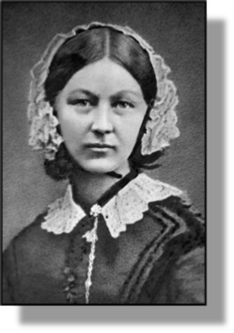 xxxxxThe English nurse Florence Nightingale, known as the “Lady with the Lamp” during the Crimean War, was born in Florence (hence her name). The daughter of a rich country gentlemen, she lived her early life in Derbyshire and London, England, and received much of her education directly from her father. Determined to become a nurse, despite her family’s opposition, in 1849 she visited a number of hospitals on the continent, and then the following year took a training course for nurses at the Institute for Protestant Deaconesses at Kaiserswerth, Germany. On her return to England in 1853 she took charge of the Hospital for the Care of Sick Gentlewomen in London. There she made noticeable improvements, but found insufficient scope for her ambitious plans. She dismissed her institution as a “little molehill”, and made it plain that she was looking for a mountain to climb.
xxxxxThe English nurse Florence Nightingale, known as the “Lady with the Lamp” during the Crimean War, was born in Florence (hence her name). The daughter of a rich country gentlemen, she lived her early life in Derbyshire and London, England, and received much of her education directly from her father. Determined to become a nurse, despite her family’s opposition, in 1849 she visited a number of hospitals on the continent, and then the following year took a training course for nurses at the Institute for Protestant Deaconesses at Kaiserswerth, Germany. On her return to England in 1853 she took charge of the Hospital for the Care of Sick Gentlewomen in London. There she made noticeable improvements, but found insufficient scope for her ambitious plans. She dismissed her institution as a “little molehill”, and made it plain that she was looking for a mountain to climb.
xxxxxHer opportunity to reach greater heights came with the outbreak of the Crimean War in October 1853. Havingxlearnt of the appalling conditions being suffered by the wounded, and encouraged by the then Secretary of State for War Sidney Herbert (1810-
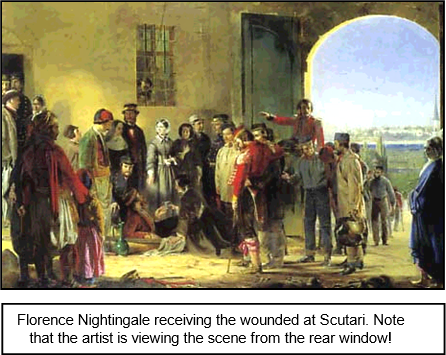
xxxxxTasked with the direction of all nursing operations in the war zone, and learning that more men were dying of disease than from their wounds, in 1855 she introduced a thorough reorganisation of the hospital system in Scutari and, later, Balaclava, purchasing local supplies to raise the standard of hygiene and general nursing care. Her dogged determination and her rare gift for administration paid off. By her tireless efforts the death rate among the sick and the wounded fell from 42% to under 3% in all the hospitals in Scutari, but not before the War Office had been persuaded to back the necessary reforms and improvements.
xxxxxThe revolution she achieved in army medical care, and her own nursing skills and devotion to duty, made her a legend in her lifetime, a household name in England and a famous figure throughout Europe. She devoted herself to the welfare of the troops, nursing the worst cases by day, assisting in the operations, and making her solitary round of the wards at night, lamp in hand, to bring comfort where it was needed. Such devotion won her much public support, and she returned home a national heroine, but she refused any official reception and shunned the limelight. From then on, though constantly ill from overwork, she devoted her life to reforming the nursing profession, raising the standards of public health, and improving the welfare of the British soldier. In 1860, for example, using a testimonial fund of £50,000 -
xxxxxIn her determination to improve the health and living conditions of the British soldier, she had private interviews with Queen Victoria and Prince Albert, and eventually persuaded the government to appoint a Royal Commission on the Health of the Army. Out of it came the founding of the Army Medical School in 1857 and a host of improvements, later outlined in her Notes on Matters Affecting the Health, Efficiency and Hospital Administration of the British Army. And following the Indian Mutiny in 1857, she turned her attention to the health of the army in India, gaining by her efforts another royal commission, and the ultimate establishment of a Sanitary Department within the India Office.
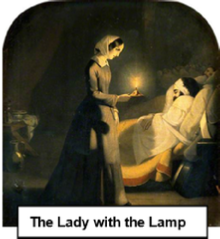 xxxxxBy the end of the century her system of education and training had been adopted across the Western world and throughout much of the British Empire, influenced in large measure by her own writings. These included Notes on Nursing in 1860 -
xxxxxBy the end of the century her system of education and training had been adopted across the Western world and throughout much of the British Empire, influenced in large measure by her own writings. These included Notes on Nursing in 1860 -
xxxxxIncidentally, Nightingale’s work during the Crimean War was admired and supported by Queen Victoria, and the American poet Henry Wadsworth Longfellow, referring to her routine visits to the wards during the night, wrote “A lady with a lamp shall stand in the great annals of the land”.
Including:
Mary Seacole and
Elizabeth Blackwell

Va-
xxxxxAnother nurse who became famous for her work in the Crimean War was the Jamaican Mary Seacole (1805-
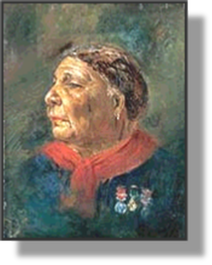 xxxxxAnother nurse who gained much popularity for her work during the Crimean War was the Jamaican Mary Seacole (1805-
xxxxxAnother nurse who gained much popularity for her work during the Crimean War was the Jamaican Mary Seacole (1805-
xxxxxOn her return to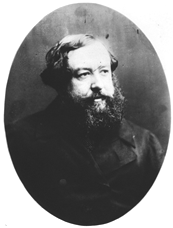 England at the end of the war she was feted as the “Angel of the Crimea”, but she was virtually destitute, having lost all her possessions to the Russians. However, The Times and the magazine Punch raised money on her behalf, as did a four-
England at the end of the war she was feted as the “Angel of the Crimea”, but she was virtually destitute, having lost all her possessions to the Russians. However, The Times and the magazine Punch raised money on her behalf, as did a four-
xxxxxIncidentally, itxwas William Howard Russell (1820-
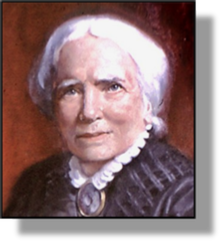
xxxxxIt was in the early 1850s that Florence Nightingale met Elizabeth Blackwell (1821-
xxxxxDetermined as a young woman to become a doctor, she worked as a teacher in Kentucky and later in North and South Carolina in order to raise money for her medical education, but she was then rejected by all the New York and Philadelphia colleges. After a dozen more rejections, she was eventually accepted by the medical school of Geneva in New York State (allegedly because her application was thought to be a hoax!) and graduated as a doctor in 1849. Perhaps not surprisingly, she then found that no hospital in America would employ her! Undeterred, in 1857, after training as a midwife in Paris, she established her own infirmary for Women and Children in Manhattan, and two years later became the first woman to be entered on the British Medical Register. Then in 1868, after playing a valuable part in selecting and training nurses during the American Civil War, she expanded her infirmary in New York to include a medical college for the training of women doctors, the first of its kind.
xxxxxIn 1869 she left New York and spent the rest of her life in Great Britain. She lectured and worked at the London School of Medicine for Women, and in 1875 was appointed Professor of Gynaecology, a post she held until 1907. She died of a stroke at her home in Hastings, Sussex, and was buried in St, Mun’s cemetery at Kilmun on Holy Loch, western Scotland. Throughout her life she was active in the anti-
xxxxxIncidentally, while in Paris in the late 1840s, taking a course in midwifery, she caught a serious eye infection and had to have her right eye removed. This put pay to her hopes of becoming a surgeon. ……
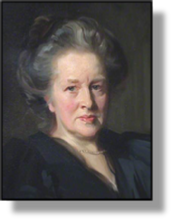
xxxxx…… The first woman to gain a medical qualification in Britain (and to be the first woman mayor in England) was Elizabeth Garrett Anderson (1836-


